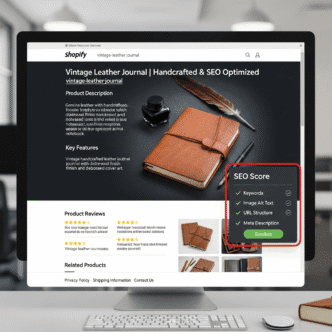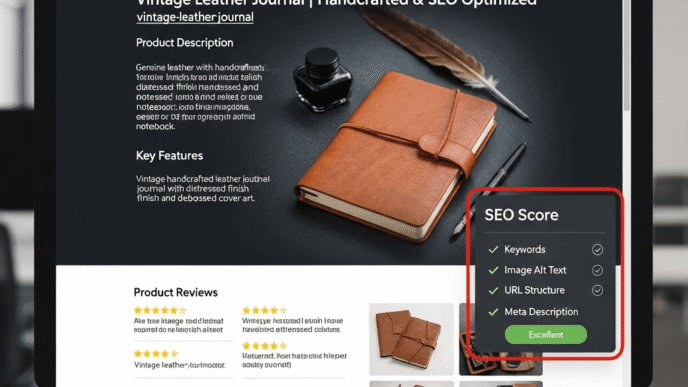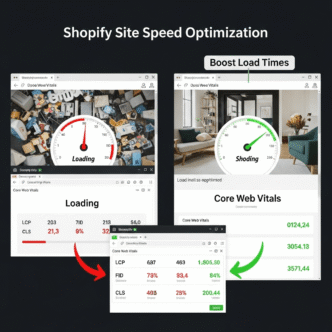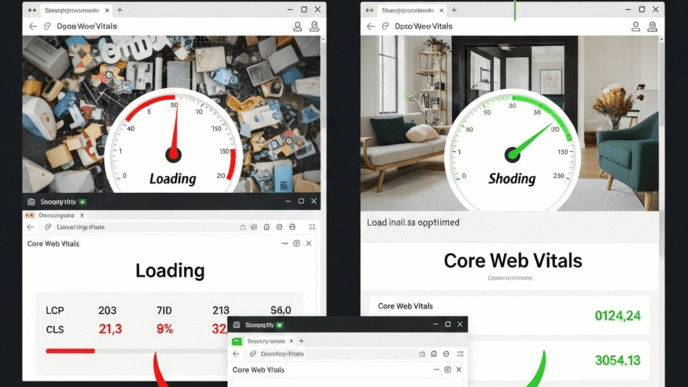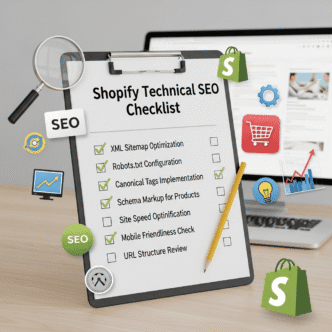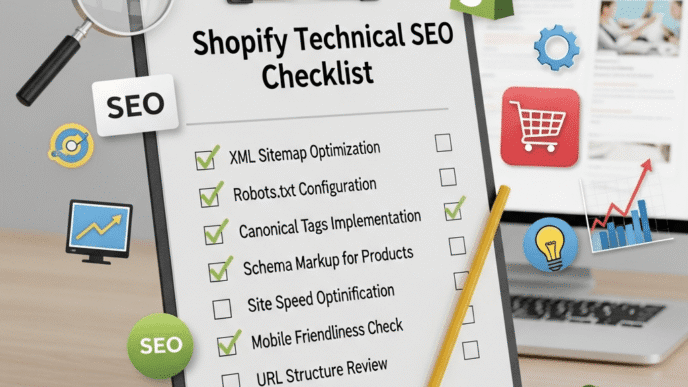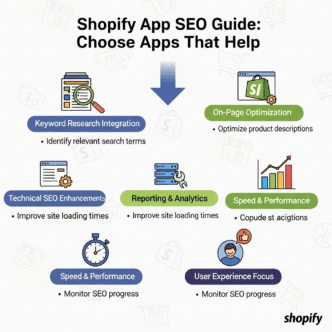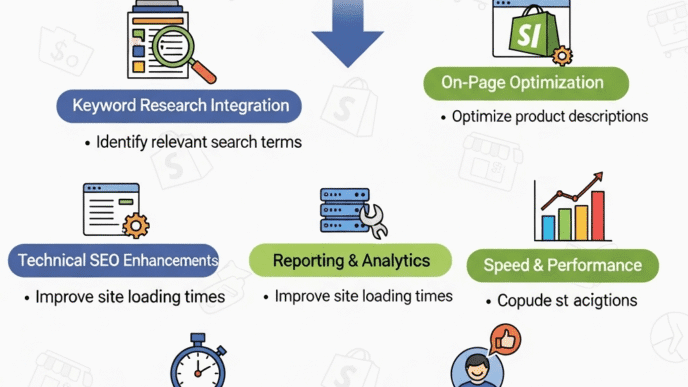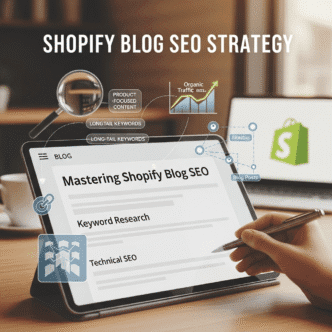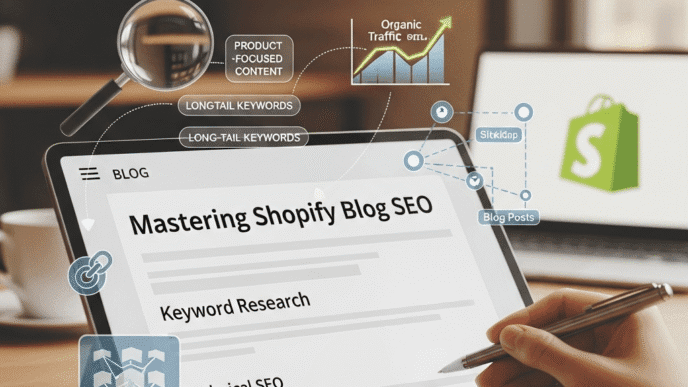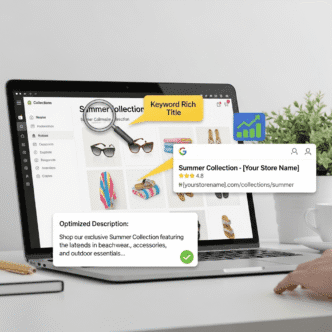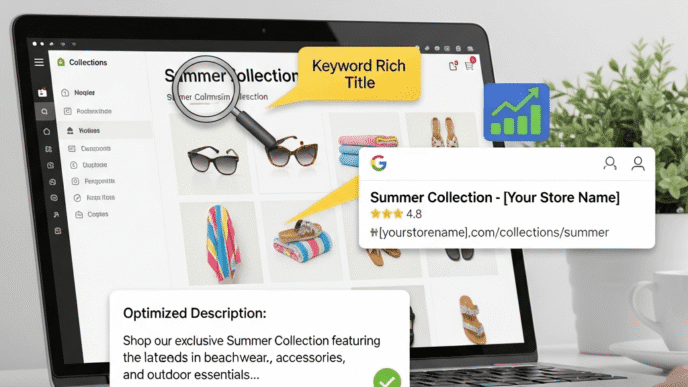You’ve built your Shopify store, added your products, and hit publish. Now you’re waiting for customers to roll in. Except… they’re not. You’re getting maybe 10 visitors a day, and your competitors are somehow ranking on Google’s first page while you’re buried on page 5.
Here’s the thing: Shopify is amazing for ecommerce, but it won’t magically rank your store. You need a proper Shopify SEO guide to turn your online store into a traffic-generating machine.
This isn’t another fluffy SEO article. We’re diving deep into everything you need to optimize your Shopify store and actually compete in 2025. Whether you’re selling handmade soap or high-end electronics, these Shopify SEO best practices will help you climb the rankings.
Let’s get started.
Table of Contents
ToggleWhat Is Shopify SEO and Why Should You Care?
Shopify SEO is the process of optimizing your online store to rank higher in search engine results. Simple as that.
Think of Google as the world’s busiest shopping mall, and SEO is what gets your store a prime location instead of hiding it in the basement. When someone searches “organic dog treats” or “minimalist leather wallets,” you want YOUR store showing up, not your competitors’.
Here’s why Shopify search optimization matters:
- 68% of online experiences begin with a search engine
- The first page of Google captures 92% of all traffic
- Organic search drives 53% of all website traffic
- SEO keeps working 24/7 without ongoing ad spend
Bottom line? Master Shopify SEO tips, and you’ll build a sustainable traffic source that doesn’t drain your bank account.
How Is Shopify SEO Different from Regular SEO?
Good question. Shopify has its own quirks.
Unlike WordPress where you control everything, Shopify is a hosted platform with built-in limitations. You can’t edit certain code sections, the URL structure is partially locked, and some technical elements are handled automatically.
But here’s the good news: Shopify handles a lot of heavy lifting for you. Fast loading times, mobile responsiveness, and SSL certificates come standard. You just need to optimize what you CAN control.
The key differences:
- URL structure limitations – Shopify adds /products/, /collections/, and /pages/ to URLs automatically
- Blogging platform – Less powerful than WordPress but sufficient for content marketing
- Apps and integrations – You’ll rely on Shopify apps for advanced SEO features
- Theme constraints – Your theme determines some SEO capabilities
Think of Shopify SEO as playing guitar with a few strings pre-tuned. You’ve got less flexibility, but you can still create beautiful music if you know what you’re doing.
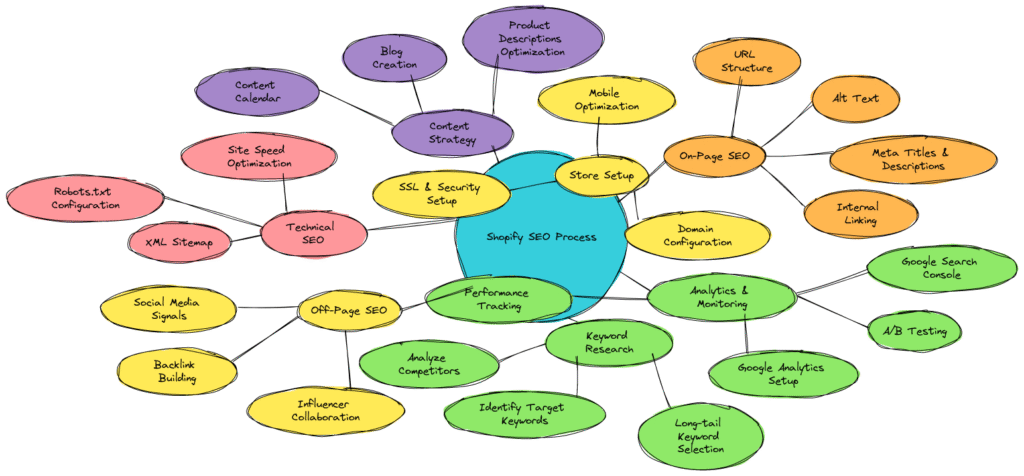
What Are the Core Shopify SEO Ranking Factors in 2025?
Google’s algorithm considers 200+ ranking factors, but not all matter equally for ecommerce.
Here are the heavy hitters for Shopify stores:
Technical SEO factors:
- Page loading speed (Core Web Vitals)
- Mobile-friendliness
- Secure HTTPS connection
- Clean site architecture
- XML sitemap and robots.txt
On-page SEO factors:
- Keyword-optimized product titles and descriptions
- Proper heading structure (H1, H2, H3)
- Meta titles and descriptions
- Image optimization with alt text
- Internal linking strategy
Content factors:
- Blog content quality and relevance
- Unique product descriptions (no manufacturer copy-paste)
- User-generated content (reviews, testimonials)
Off-page factors:
- Quality backlinks from relevant sites
- Brand mentions and citations
- Social signals (indirect impact)
User experience signals:
- Click-through rate from search results
- Bounce rate and dwell time
- Mobile usability
Master these, and you’ll improve Shopify rankings faster than most competitors.
How Do You Research the Right Keywords for Your Shopify Store?
Keywords are the foundation of everything. Get this wrong, and all your SEO efforts crumble.
Here’s your keyword research game plan:
Step 1: Understand Keyword Intent Types
Not all keywords are created equal. There are four main types:
- Informational – “how to clean leather boots”
- Navigational – “Nike official store”
- Commercial investigation – “best running shoes 2025”
- Transactional – “buy men’s running shoes online”
For product pages, focus on transactional and commercial keywords. For blog content, target informational queries that lead to conversions.
Step 2: Use These Free Keyword Research Tools
You don’t need expensive tools starting out:
- Google Keyword Planner – Free and shows search volume
- Google Search Console – See what you already rank for
- Answer the Public – Find question-based keywords
- Amazon Autocomplete – Shows what people actually search for
- Competitor analysis – Steal ideas from ranking competitors
Step 3: Target Long-Tail Keywords First
Forget competing for “shoes” (impossible). Instead target long-tail keywords for Shopify like:
- “waterproof hiking boots for women size 8”
- “vegan leather laptop bag 15 inch”
- “organic cotton baby clothes wholesale”
These convert better and you’ll actually have a chance to rank.
Pro Tip: Create a spreadsheet with columns for keyword, search volume, difficulty, and intent. Prioritize low-competition keywords with commercial intent for quick wins.
Step 4: Map Keywords to Pages
Each product, collection, and blog post should target ONE primary keyword and 2-3 related terms. Don’t keyword stuff—spread them naturally across your site.
Example mapping:
- Product page → “minimalist leather wallet men”
- Collection page → “men’s leather accessories”
- Blog post → “how to care for leather wallets”
Common Keyword Research Mistakes to Avoid
❌ Targeting only high-volume keywords – These are usually too competitive for new stores
❌ Ignoring search intent – Ranking for informational keywords won’t drive sales if you need transactional traffic
❌ Keyword stuffing – Using your keyword 50 times per page looks spammy and hurts rankings
❌ Forgetting about related terms – Google uses semantic search, so include LSI keywords naturally
How Do You Optimize Shopify Product Pages for SEO?
Your product pages are money pages. Get these right, and you’ll see sales roll in.
Product Titles: Your First SEO Battleground
Your product title appears in three critical places: your H1 tag, meta title, and URL.
Bad example: “Awesome Wallet – Style #2847”
Good example: “Minimalist Leather Wallet for Men | RFID Blocking | Slim Design”
Formula: [Primary Keyword] + [Key Feature] + [Benefit/USP]
Keep it under 60 characters for the meta title to avoid truncation in search results.
Write Product Descriptions That Sell AND Rank
Stop copying manufacturer descriptions. Duplicate content can significantly harm your SEO performance, and generic text doesn’t convert.
Your product description checklist:
- Start with the primary benefit (not features)
- Include your target keyword naturally within the first 100 words
- Use bullet points for scannability
- Add 300-500 words minimum (more for competitive products)
- Include LSI keywords like “genuine leather,” “handcrafted,” “durable construction”
- Answer common questions (size, care, shipping)
- Add social proof (reviews, testimonials)
Pro Tip: Use the PAS formula (Problem-Agitate-Solution). “Tired of bulky wallets ruining your pocket line? That thick leather brick is killing your style. Our ultra-slim wallet holds 8 cards and barely adds bulk.”
Optimize Product Images for Speed and Search
Images slow down sites and hurt rankings if not optimized properly.
Image optimization checklist:
- Compress images to under 200KB (use TinyPNG or Shopify’s compression)
- Use descriptive file names: “slim-leather-wallet-brown.jpg” (not “IMG_2847.jpg”)
- Write ALT text with keywords: “Slim brown leather wallet with RFID protection”
- Use WebP format when possible
- Enable lazy loading for below-fold images
Google Image Search accounts for over 22% of all web searches. Don’t ignore it.
Meta Descriptions That Increase Click-Through Rates
Meta descriptions don’t directly impact rankings, but they influence clicks (which DOES affect rankings).
Winning meta description formula:
- 150-160 characters max
- Include primary keyword early
- Add a benefit or unique value prop
- Include a call-to-action
- Create urgency or curiosity when relevant
Example: “Shop our minimalist leather wallet with RFID protection. Holds 8 cards, slim design, lifetime warranty. Free shipping on orders $50+. Order now!”
URL Structure for Shopify Products
Shopify automatically adds /products/ to all product URLs. You can’t change this, but you can control the handle.
Bad URL: shopify.com/products/product-1234
Good URL: shopify.com/products/minimalist-leather-wallet-men
Keep URLs short, descriptive, and keyword-rich. Remove stop words like “and,” “the,” “for” when possible.
Product Page Optimization Mistakes to Avoid
❌ Using manufacturer descriptions – This creates duplicate content across thousands of websites
❌ Neglecting mobile optimization – Mobile commerce accounts for 60% of all ecommerce sales
❌ Missing schema markup – Product schema helps you get rich snippets with ratings and pricing
❌ Poor image quality – Low-res images hurt conversions and make your brand look cheap
How Do You Optimize Shopify Collection Pages?
Collection pages are goldmine opportunities that most store owners completely waste.
Think about it: Someone searching “men’s leather wallets” probably isn’t ready to buy ONE specific wallet. They want to browse options. That’s where your collection page SEO comes in.
Collection Page Title and Description
Don’t leave these blank or use Shopify’s auto-generated text.
Write a compelling 200-300 word description that:
- Explains what products are in this collection
- Includes your primary collection keyword multiple times naturally
- Answers why someone should buy from you
- Uses semantic keywords related to the product category
Place this text ABOVE your products, not hidden below. Google prioritizes content higher on the page.
Collection URL Optimization
Like products, Shopify adds /collections/ automatically. Your job is optimizing the handle.
Example:
- Primary keyword: “handmade ceramic mugs”
- URL: yourstore.com/collections/handmade-ceramic-mugs
Internal Linking from Collections
Link to related collections and relevant blog posts from your collection descriptions. This helps Google understand your site structure and keeps visitors exploring longer.
Example links:
- From “Men’s Wallets” collection → Link to “Leather Care Guide” blog post
- Link to related collection → “Men’s Belts” or “Leather Accessories”
What’s the Best Shopify Site Structure for SEO?
Site architecture might sound boring, but it’s crucial for Shopify search optimization.
Think of your site structure like a pyramid:
Homepage (top of pyramid) ↓ Collection Pages (category level) ↓ Product Pages (bottom level) ↓ Blog Posts (supporting content)
The 3-Click Rule
Every product should be reachable within 3 clicks from your homepage. The farther a page is from your homepage, the less SEO authority it receives.
Bad structure: Homepage → Menu → Submenu → Collection → Subcollection → Product (6 clicks)
Good structure: Homepage → Collection → Product (3 clicks)
Create Logical Category Hierarchies
Group products in ways that make sense to customers AND search engines.
Example for a clothing store:
- Men's Clothing
→ T-Shirts
→ Jeans
→ Jackets
- Women's Clothing
→ Dresses
→ Tops
→ Pants
Avoid orphan pages (pages with no internal links pointing to them). Google struggles to find and rank these.
Navigation Menu Optimization
Your main navigation passes the most SEO authority. Include your most important collections here.
Use descriptive anchor text with keywords:
- ❌ “Shop Now”
- ✅ “Men’s Leather Wallets”
Pro Tip: Add a footer navigation with links to key collections, policies, and blog categories. This creates more internal linking opportunities across your entire site.
Site Structure Mistakes to Avoid
❌ Too many subcategories – Keeps products too far from homepage
❌ Duplicate category structures – Confuses Google about which page to rank
❌ No breadcrumb navigation – Hurts both user experience and SEO
❌ Broken internal links – Check regularly with tools like Screaming Frog
How Do You Fix Common Shopify Technical SEO Issues?
Technical SEO is where most Shopify owners get lost. Let’s simplify it.
Improve Your Shopify Site Speed
Speed is a direct ranking factor AND affects conversions. A 1-second delay in page load time can decrease conversions by 7%.
Quick wins to speed up your Shopify store:
- Choose a lightweight theme (avoid theme bloat)
- Remove unused apps (each app adds code)
- Compress all images before uploading
- Enable Shopify’s built-in CDN
- Minimize use of custom fonts
- Lazy load images below the fold
- Reduce redirects
Test your speed with <a href=”https://pagespeed.web.dev/” rel=”nofollow”>Google PageSpeed Insights</a>. Aim for a score above 70 on mobile.
Fix Duplicate Content Issues
Shopify creates duplicate content by default. Same product accessible through multiple URLs? Google sees duplicates.
Example duplicate URLs:
- yourstore.com/products/wallet
- yourstore.com/collections/mens-wallets/products/wallet
- yourstore.com/collections/leather-goods/products/wallet
Solution: Shopify automatically adds canonical tags pointing to the main product URL. Double-check this is working in your theme’s code.
Set Up Your robots.txt File
This tells search engines which pages to crawl and which to ignore.
Access yours at: yourstore.com/robots.txt
Shopify handles most of this automatically, but verify you’re:
- Allowing crawling of product and collection pages
- Blocking admin, checkout, and cart pages
- Blocking /search and filtering URLs
XML Sitemap Configuration
Shopify auto-generates your sitemap at: yourstore.com/sitemap.xml
Submit this to <a href=”https://search.google.com/search-console” rel=”nofollow”>Google Search Console</a> to help Google discover your pages faster.
Check that your sitemap includes:
- Product pages
- Collection pages
- Blog posts
- Regular pages
Remove low-value pages from your sitemap (like “/pages/password” or test pages).
Schema Markup for Rich Snippets
Schema markup helps Google understand your content and can earn you rich results (star ratings, price, availability).
Shopify themes include basic product schema by default. You should add:
- Review schema (shows star ratings in search results)
- Breadcrumb schema (shows navigation path)
- Organization schema (brand information)
- FAQ schema (for collection pages or blog posts)
Use the <a href=”https://schema.org/” rel=”nofollow”>Schema.org</a> documentation to generate JSON-LD code, then add it to your theme.
Technical SEO Mistakes to Avoid
❌ Ignoring mobile-first indexing – Google predominantly uses mobile versions of content for indexing and ranking
❌ Missing SSL certificate – Shopify provides this, but ensure it’s active
❌ Redirect chains – Multiple redirects slow down crawling and page speed
❌ Blocking CSS/JavaScript in robots.txt – Prevents Google from rendering pages properly
How Do You Create an SEO-Friendly Shopify Blog?
Content marketing is your secret weapon for long-tail keyword rankings and building authority.
Your blog serves three purposes:
- Ranks for informational keywords your products can’t target
- Builds trust and expertise in your niche
- Creates internal linking opportunities to products
Pick Blog Topics That Drive Sales
Don’t just write random posts. Target keywords at different stages of the buyer journey.
Blog topic formula:
Top of Funnel (Awareness):
- “How to Choose the Right [Product Type]”
- “10 Signs You Need a New [Product]”
- “[Product] Buying Guide for Beginners”
Middle of Funnel (Consideration):
- “[Your Product] vs [Competitor Product]”
- “Best [Product Type] for [Specific Use Case]”
- “[Product] Reviews: What Real Users Say”
Bottom of Funnel (Decision):
- “How to Use [Your Product]”
- “[Product] Care and Maintenance Guide”
- “Frequently Asked Questions About [Product]”
Blog Post SEO Checklist
Every post needs these elements:
- ✅ Target keyword in title, H1, URL, and first paragraph
- ✅ H2 and H3 subheadings with related keywords
- ✅ 1,500+ words (comprehensive beats short)
- ✅ Internal links to products and collections (3-5 per post)
- ✅ External links to authority sources
- ✅ Optimized images with ALT text
- ✅ Meta description (150-160 characters)
- ✅ Clear call-to-action linking to products
Content Cluster Strategy
Instead of random posts, build content clusters around pillar topics.
Example cluster for “Coffee Equipment Store”:
Pillar Post: “Complete Guide to Home Coffee Brewing”
Cluster Posts (linking to pillar):
- “French Press vs Pour Over: Which is Better?”
- “How to Grind Coffee Beans Properly”
- “Best Water Temperature for Coffee Brewing”
- “Coffee Grinder Maintenance Guide”
Each cluster post links to the pillar, and the pillar links to all clusters. This builds topical authority in Google’s eyes.
Pro Tip: Include 3-5 internal links in every blog post to relevant products. Use natural anchor text like “check out our ceramic pour-over coffee makers” instead of generic “click here.”
Blogging Mistakes to Avoid
❌ Publishing thin content – Posts under 500 words rarely rank
❌ Keyword stuffing – Unnatural keyword density hurts readability and rankings
❌ No internal links – Missing opportunities to drive traffic to products
❌ Ignoring search intent – Writing about what YOU want instead of what customers search for
❌ Inconsistent publishing – Sporadic posts don’t build momentum
What Are the Best Shopify SEO Apps in 2025?
Shopify’s native SEO features are decent but limited. These apps fill the gaps.
SEO App Comparison Table
| App Name | Best For | Key Features | Pricing |
|---|---|---|---|
| Plug in SEO | Beginners | SEO audits, broken link checker, meta template editor | Free – $20/month |
| SEO Manager | Complete optimization | Bulk editing, JSON-LD schema, image optimization | $20/month |
| Smart SEO | Automation | Auto-generates meta tags, alt text, JSON-LD | $4.99/month |
| Yoast SEO | Content optimization | Real-time SEO analysis, readability scores | $19/month |
| JSON-LD for SEO | Schema markup | Advanced schema for products, reviews, breadcrumbs | $14.99/month |
| Booster SEO & Image Optimizer | Image SEO | Auto alt text, image compression, meta optimization | Free – $34.99/month |
The Essential App Stack
You don’t need all of them. Here’s my recommended combo:
For beginners:
- Plug in SEO (for audits and fixes)
- Smart SEO (for automation)
- Judge.me (for review schema)
For advanced users:
- SEO Manager (for granular control)
- JSON-LD for SEO (for advanced schema)
- TinyIMG (for image compression)
Warning: Don’t install too many SEO apps. Conflicting code can cause issues, and each app slows your site slightly.
Must-Have SEO Features in Apps
Look for apps that provide:
- Bulk meta title and description editing
- Automatic image ALT text generation
- JSON-LD structured data
- 404 error monitoring
- Redirect management
- SEO audit and checklist
App-Related Mistakes to Avoid
❌ Installing duplicate functionality – Multiple apps doing the same thing creates conflicts
❌ Not testing after installation – Always check that apps work correctly
❌ Ignoring app performance impact – Monitor site speed after installing new apps
❌ Using outdated apps – Check last update date and reviews before installing
How Do You Build Backlinks for Your Shopify Store?
Backlinks remain one of Google’s strongest ranking signals. Backlinks are among the top three ranking factors for Google. You need them to compete.
But here’s the thing: Building links to ecommerce sites is harder than blogs or SaaS sites. Nobody naturally links to product pages.
Link Building Strategies That Work for Ecommerce
1. Create Linkable Assets
Build resources people WANT to link to:
- Ultimate buying guides
- Industry statistics and data
- Free tools or calculators
- Original research or surveys
- Comprehensive comparison charts
Example: A supplement store creates “The 2025 State of Fitness Nutrition Report” with survey data. Fitness blogs and magazines link to cite the statistics.
2. Digital PR and Newsjacking
Connect your products to trending topics or create newsworthy stories.
Example: An eco-friendly product store sends a press release about “How Our Packaging Saves 10,000 Plastic Bottles Annually.” Local news sites and eco blogs pick it up.
3. Guest Posting with Product Mentions
Write valuable content for industry blogs. Naturally mention your products where relevant.
Pro Tip: Don’t pitch “I’ll write a guest post.” Instead, pitch specific topics that solve their audience’s problems, then subtly reference your store as an example or resource.
4. Broken Link Building
Find broken links on industry websites, then suggest your content as a replacement.
Process:
- Use tools like Ahrefs or Broken Link Builder extension
- Find dead product pages or resources in your niche
- Email the site: “Hey, I noticed this broken link on your page about [topic]. I have a similar resource that might work as a replacement: [your URL]”
5. Get Listed in Industry Directories
Not all directories matter, but niche-specific ones do.
Find directories by searching:
- “[Your niche] + directory”
- “[Your product type] + resources”
- “Best [product] stores”
6. Leverage User-Generated Content
Encourage customers to blog about your products. Send free products to micro-influencers and bloggers in exchange for honest reviews (with a link back).
7. Strategic Partnerships
Partner with complementary brands for:
- Co-created content
- Bundle deals
- Joint webinars or guides
- Cross-promotions
Example: A yoga mat store partners with a yoga instructor training platform to create “The Complete Yoga Studio Setup Guide” with product links from both brands.
What NOT to Do
Avoid these black-hat tactics:
- ❌ Buying links from link farms
- ❌ Mass directory submissions to low-quality sites
- ❌ Comment spam on blogs
- ❌ Private blog networks (PBNs)
- ❌ Excessive link exchanges (“I’ll link to you if you link to me”)
Google’s algorithm spots these instantly. You’ll get penalized, not ranked.
Pro Tip: Focus on earning 2-5 quality backlinks per month from relevant, authoritative sites rather than chasing hundreds of low-quality links. Quality trumps quantity every time.
Link Building Mistakes to Avoid
❌ Focusing only on high DA sites – Domain Authority is just one metric; relevance matters more
❌ Using exact match anchor text repeatedly – Looks unnatural and can trigger penalties
❌ Ignoring nofollow links – They still drive traffic and brand visibility
❌ Not tracking your backlinks – Use Google Search Console to monitor your link profile
How Do You Optimize Shopify for Local SEO?
If you have a physical location or serve specific geographic areas, local SEO for Shopify stores can drive massive traffic.
Set Up Google Business Profile
This is non-negotiable for local businesses.
Optimization checklist:
- Complete every section (hours, services, attributes)
- Choose the most specific business categories
- Upload high-quality photos (exterior, interior, products, team)
- Add products directly to your profile
- Collect and respond to reviews regularly
- Post weekly updates (offers, events, new products)
Include your Shopify store URL in your Google Business Profile.
Local SEO On-Page Elements
Add these to your Shopify store:
Location pages: If you serve multiple cities, create individual pages for each:
- yourstore.com/pages/brooklyn-location
- yourstore.com/pages/manhattan-location
Include:
- NAP (Name, Address, Phone) in text format
- Embedded Google Map
- Unique content about each location
- Local keywords (“Brooklyn leather goods store”)
- Customer reviews and testimonials
- Directions and parking information
Footer NAP consistency: Display your business name, address, and phone number in the footer of every page. Use the same format everywhere online.
Local schema markup: Add LocalBusiness schema to your homepage:
{
"@context": "https://schema.org",
"@type": "LocalBusiness",
"name": "Your Store Name",
"address": {
"@type": "PostalAddress",
"streetAddress": "123 Main Street",
"addressLocality": "Brooklyn",
"addressRegion": "NY",
"postalCode": "11201"
},
"telephone": "+1-555-555-5555"
}
Build Local Citations
Get your business listed on:
- Yelp
- Yellow Pages
- Better Business Bureau
- Chamber of Commerce
- Industry-specific directories
- Local business associations
Consistency is critical. Use the exact same business name, address, and phone number everywhere.
Encourage Customer Reviews
Reviews impact both local and organic rankings.
Review generation strategies:
- Email follow-up after purchase with review request
- Include review links on packaging inserts
- Offer small incentives (5% discount on next order)
- Make it easy (direct link, not multi-step process)
- Respond to every review (positive and negative)
Pro Tip: Feature customer reviews with location mentions on your site. “⭐⭐⭐⭐⭐ ‘Best coffee shop in Austin!’ – Sarah M., Austin, TX” These provide natural geo-targeted keywords throughout your site.
Local SEO Mistakes to Avoid
❌ Inconsistent NAP across platforms – Google gets confused about which information is correct
❌ Ignoring negative reviews – Not responding looks bad to both Google and customers
❌ Missing Google Business Profile – You’re invisible in local searches
❌ No location-specific content – Generic content doesn’t rank for “near me” searches
How Do You Track and Measure Shopify SEO Success?
You can’t improve what you don’t measure. Here’s what to track.
Essential SEO Metrics
1. Organic Traffic
- Where to find it: Google Analytics (Acquisition → Traffic Acquisition → Organic Search)
- What to track: Total sessions, new vs. returning users, traffic trends
2. Keyword Rankings
- Tools: Google Search Console, Ahrefs, SEMrush
- What to track: Position changes for target keywords, new ranking keywords, lost rankings
3. Click-Through Rate (CTR)
- Where to find it: Google Search Console (Performance → Pages)
- What to track: Average CTR, pages with low CTR despite good rankings
4. Conversion Rate from Organic Traffic
- Where to find it: Google Analytics (Conversions → Attribution)
- What matters: Revenue and conversions specifically from organic search
5. Indexed Pages
- Where to check: Google Search Console (Coverage report)
- What matters: Percentage of pages indexed vs. submitted
6. Page Load Speed
- Tools: Google PageSpeed Insights, GTmetrix
- Target: 70+ score on mobile, under 3 seconds load time
7. Backlink Profile
- Tools: Ahrefs, Moz, SEMrush
- What to track: Total referring domains, new links, lost links, domain authority
Google Search Console Setup
If you haven’t connected your store to Google Search Console yet, do it NOW.
Setup steps:
- Go to search.google.com/search-console
- Add your property (yourstore.myshopify.com)
- Verify ownership via HTML tag or DNS
- Submit your sitemap (yourstore.com/sitemap.xml)
What to monitor weekly:
- Performance report (clicks, impressions, CTR, position)
- Coverage issues (crawl errors, indexing problems)
- Mobile usability errors
- Core Web Vitals report
Set Up Goal Tracking in Google Analytics
Track these events:
- Add to cart
- Initiated checkout
- Purchase completed
- Newsletter signups
- Product page views
This shows which SEO efforts actually drive revenue, not just traffic.
Pro Tip: Create a monthly SEO dashboard (Google Sheets or Data Studio) with your key metrics. Review it religiously. Spot trends, identify problems early, and double down on what’s working.
Tracking Mistakes to Avoid
❌ Not setting up conversion tracking – Traffic without conversions is meaningless
❌ Ignoring engagement metrics – Bounce rate and time on page indicate content quality
❌ Tracking vanity metrics only – Rankings don’t matter if they don’t drive revenue
❌ Not segmenting data – Analyze mobile vs desktop, new vs returning visitors separately
What Are Common Shopify SEO Mistakes to Avoid?
Even experienced store owners make these errors. Don’t be one of them.
Mistake #1: Thin or Duplicate Product Descriptions
Copying manufacturer descriptions = SEO suicide. Google penalizes duplicate content, and generic text doesn’t convert.
Solution: Write unique 300+ word descriptions for every product. If you have hundreds of products, prioritize your top sellers and work through the rest systematically.
Mistake #2: Ignoring Image Optimization
Huge image files destroy your site speed and rankings.
Solution: Compress every image before uploading. Use tools like TinyPNG or Squoosh. Rename files with keywords and add descriptive ALT text.
Mistake #3: No Blog Strategy
Products pages alone won’t rank for most searches. You need supporting content.
Solution: Publish 2-4 blog posts monthly targeting informational keywords in your niche. Build content clusters around your main product categories.
Mistake #4: Missing Internal Links
If products and pages aren’t linked together, Google struggles to understand your site structure.
Solution: Add 3-5 internal links to every page. Link from collections to products, blog posts to products, and related products to each other.
Mistake #5: Neglecting Mobile Optimization
Mobile commerce accounts for 60% of all ecommerce sales. If your store doesn’t work perfectly on phones, you’re losing both traffic and sales.
Solution: Test your store on multiple mobile devices. Check that buttons are tappable, text is readable without zooming, and checkout flows smoothly.
Mistake #6: Not Building Backlinks
You can perfect every on-page element, but without backlinks, you won’t outrank established competitors.
Solution: Dedicate time monthly to link building. Start with easy wins (directories, partnerships, guest posts) and build from there.
Mistake #7: Installing Too Many Apps
Every app adds code to your store. Too many = slow loading times = poor rankings.
Solution: Audit your apps quarterly. Remove anything you’re not actively using. Consolidate functionality where possible.
Mistake #8: Forgetting Meta Descriptions
Leaving these blank or using auto-generated text wastes a huge opportunity to increase click-through rates.
Solution: Write custom meta descriptions for all products, collections, and blog posts. Include your target keyword and a compelling benefit or CTA.
Mistake #9: Ignoring Core Web Vitals
Google prioritizes sites with good user experience metrics.
Solution: Test regularly with PageSpeed Insights and fix issues immediately. Focus on LCP, FID, and CLS scores.
Mistake #10: Not Optimizing for Voice Search
Solution: Target conversational long-tail keywords, create FAQ sections, and optimize for local “near me” searches. Structure content to answer specific questions concisely.
How Long Does Shopify SEO Take to Show Results?
The question everyone asks. The answer: it depends (I know, annoying).
Realistic timeline:
Months 1-3: Foundation and Early Wins
- Technical SEO fixes implemented
- On-page optimization completed
- First 5-10 blog posts published
- Results: Small ranking improvements for long-tail keywords, minimal traffic increase
Months 4-6: Momentum Building
- Blog content gaining traction
- First backlinks acquired
- Product pages starting to rank
- Results: 30-50% organic traffic increase, some product pages hitting page 2-3
Months 7-12: Significant Growth
- Content clusters established
- Consistent backlink velocity
- Authority building in niche
- Results: 100-200% organic traffic increase, multiple page 1 rankings
12+ Months: Compounding Returns
- Established domain authority
- Consistent content production
- Natural backlink accumulation
- Results: Organic traffic as primary traffic source, 300%+ growth from baseline
Factors that speed up results:
- Low-competition niche
- Strong existing brand presence
- Aggressive content production
- Budget for quality backlinks
- Technical site optimization
Factors that slow down results:
- Highly competitive niche
- New domain with no authority
- Limited content production
- No backlink strategy
- Technical issues or poor site speed
Pro Tip: Focus on quick win keywords first—low competition, long-tail terms with clear commercial intent. These can rank in weeks rather than months and provide early momentum (and revenue) while you tackle harder keywords.
What’s the Future of Shopify SEO in 2025 and Beyond?
SEO constantly evolves. Here’s what’s shaping ecommerce search optimization right now.
AI and Search Generative Experience (SGE)
Google’s AI-powered results now appear at the top of search results for many queries. This changes the game.
How AI is transforming Shopify SEO:
According to industry research, AI-generated search results now appear for over 86% of queries, fundamentally changing how users interact with search results.
How to adapt:
- Focus on comprehensive, authoritative content that AI will cite
- Optimize for featured snippets and “People Also Ask” boxes
- Build strong brand recognition (branded searches bypass AI overviews)
- Create content answering specific questions thoroughly
- Include first-hand experience and expertise (E-E-A-T signals)
AI-powered product descriptions: While AI tools can help, don’t rely on them entirely. Google can detect purely AI-generated content lacking human oversight. Use AI as an assistant, not a replacement.
Voice Search Optimization
Smart speakers and voice assistants are changing search behavior.
Voice search optimization tactics:
- Target conversational long-tail keywords (“where can I buy organic dog treats near me”)
- Write in natural language with question-and-answer format
- Optimize for local searches
- Focus on featured snippet optimization (voice assistants read these)
- Use schema markup for better voice search visibility
Core Web Vitals and User Experience
Google increasingly prioritizes user experience signals.
What matters now:
- Largest Contentful Paint (LCP) – Page loading performance (should be under 2.5 seconds)
- Interaction to Next Paint (INP) – Responsiveness (replaced FID in 2024)
- Cumulative Layout Shift (CLS) – Visual stability (should be under 0.1)
Optimization priorities:
- Faster hosting and CDN
- Optimized images and lazy loading
- Minimal JavaScript and CSS
- Stable layout (no sudden shifts as page loads)
- Prioritize above-the-fold content loading
E-E-A-T (Experience, Expertise, Authoritativeness, Trustworthiness)
Google wants to rank content from trustworthy sources, especially for products affecting health or finances.
Build E-E-A-T by:
- Adding detailed “About Us” and “Team” pages with real people
- Featuring expert contributors or certifications
- Collecting and displaying customer reviews prominently
- Earning mentions and links from authoritative sites
- Being transparent about business practices
- Adding author bios to blog content
- Showing real product testing and first-hand experience
Video Content for SEO
Video is becoming essential for product pages and content marketing.
Video SEO strategy:
- Create product demo videos (embed on product pages)
- Post “how-to” video content on blog posts
- Optimize video titles, descriptions, and transcripts
- Upload videos to YouTube and embed on your site
- Add video schema markup
Statistics: Product videos can increase conversions by up to 80%, and pages with video are 53 times more likely to rank on Google’s first page.
Zero-Click Searches
An increasing number of searches are answered directly in search results without clicks.
How to adapt:
- Optimize for featured snippets to maintain visibility
- Focus on branded searches and product-specific queries
- Create unique value that can’t be summarized in a snippet
- Use schema markup to appear in rich results
- Build brand awareness through multiple channels
Pro Tip: The stores that win in 2025 and beyond won’t just optimize for today’s Google—they’ll build genuine authority, create exceptional user experiences, and earn real advocacy from customers. Focus on sustainable, white-hat strategies that weather algorithm updates.
Real-World Shopify SEO Success Stories
Let’s look at stores that crushed it with SEO.
Case Study 1: Outdoor Gear Retailer
Starting Point:
- 500 monthly organic visitors
- Zero ranking keywords on page 1
- Generic product descriptions
- No blog content
Strategy Implemented:
- Rewrote all product descriptions (200+ products) with unique content
- Created 50 comprehensive buying guides and how-to articles
- Built topical authority around hiking and camping
- Acquired 80 quality backlinks through digital PR and guest posting
Results After 14 Months:
- 15,000 monthly organic visitors (3000% increase)
- 120 keywords ranking on page 1
- Organic traffic driving 45% of total revenue
- Average order value 22% higher from organic than paid traffic
Key Takeaway: Content clusters and unique product descriptions matter more than anything else for competitive niches.
Case Study 2: Handmade Jewelry Store
Starting Point:
- Brand new store with zero domain authority
- 50 monthly organic visitors
- Competing in saturated “handmade jewelry” niche
- Limited budget for marketing
Strategy Implemented:
- Focused exclusively on ultra-specific long-tail keywords (“moonstone engagement rings rose gold,” “handcrafted boho ankle bracelets”)
- Created detailed collection pages with 500+ word descriptions
- Published 2 blog posts weekly targeting “how to style” and “jewelry care” queries
- Leveraged Instagram for user-generated content and natural backlinks
- Partnered with 10 micro-influencers in bohemian lifestyle niche
Results After 10 Months:
- 4,200 monthly organic visitors
- 85 product pages ranking in top 3 positions for long-tail keywords
- 30% conversion rate from organic blog traffic
- Built email list of 8,000 subscribers through content marketing
Key Takeaway: In saturated niches, hyper-specific long-tail SEO for Shopify stores beats trying to compete for broad keywords. Go narrow and deep.
Case Study 3: Fitness Supplement Brand
Starting Point:
- Established brand with good social following
- 2,000 monthly organic visitors
- Weak content strategy
- Manufacturer descriptions on all products
- No structured data implementation
Strategy Implemented:
- Added comprehensive product schema markup with reviews, pricing, and availability
- Created “Supplement University” content hub with science-backed articles
- Implemented internal linking strategy connecting educational content to products
- Built partnerships with fitness coaches and nutritionists for backlinks
- Optimized for “best supplements for [specific goal]” comparison keywords
Results After 8 Months:
- 22,000 monthly organic visitors
- Featured snippets for 40+ high-value keywords
- Rich results showing in 70% of product searches
- 156% increase in organic revenue
- Average organic session duration increased from 1:20 to 4:35
Key Takeaway: Structured data and rich results can dramatically increase visibility and CTR, especially for competitive product categories.
Advanced Shopify SEO Tactics for 2025
Ready to level up? These tactics separate good stores from great ones.
Programmatic SEO for Large Catalogs
If you have hundreds or thousands of products, manually optimizing each page is impossible.
Programmatic SEO strategy:
Create template-based pages that auto-generate optimized content using product attributes.
Example template for product titles: [Product Type] | [Key Feature] | [Brand] | [Size/Variant]
Example template for descriptions:
Looking for a [product type] that [primary benefit]? Our [product name] is perfect for [target customer].
Key features:
- [Attribute 1]: [Benefit]
- [Attribute 2]: [Benefit]
- [Attribute 3]: [Benefit]
[Product] is ideal for [use case]. Made from [material], this [product type] offers [unique value proposition].
Tools to use:
- Shopify bulk editor for meta fields
- Custom Liquid code in theme templates
- Apps like Excelify or Matrixify for bulk updates
- CSV imports with macro formulas
Pro Tip: Create 10 manual examples first, then identify patterns you can automate. Never sacrifice quality for scale—templates should create unique, valuable content, not spun garbage.
Competitor Gap Analysis
Find keywords your competitors rank for that you don’t.
Process:
Identify 3-5 direct competitors ranking above you
Use Ahrefs or SEMrush to analyze their organic keywords
Export their keyword list and filter for:
- Keywords with search volume 100+
- Keywords in positions 1-10
- Keywords your site doesn’t rank for
Prioritize keywords by:
- Commercial intent (buying keywords first)
- Keyword difficulty (start with achievable targets)
- Relevance to your products
Create content or optimize pages targeting those gaps
Example findings:
- Competitor ranks for “vegan leather wallet care” (you don’t have this content)
- Competitor has collection page for “minimalist wallets under $50” (you don’t have this segment)
- Competitor ranks for “wallet gift box” (you don’t optimize for gift searches)
Each gap is an opportunity to steal traffic.
FAQ Schema for Product Pages
Structured FAQ content can earn you featured snippets and “People Also Ask” placements.
Implementation:
Add an FAQ section to product pages answering common questions:
- Is this product machine washable?
- What’s the return policy?
- How long does shipping take?
- What sizes do you offer?
- Is this suitable for [specific use]?
Then add FAQ schema markup:
{
"@context": "https://schema.org",
"@type": "FAQPage",
"mainEntity": [{
"@type": "Question",
"name": "How do I care for my leather wallet?",
"acceptedAnswer": {
"@type": "Answer",
"text": "Clean your leather wallet with a damp cloth and mild soap. Apply leather conditioner every 3-6 months to prevent cracking."
}
}]
}
This increases chances of appearing in rich results and voice search answers.
Seasonal SEO Campaigns
Plan content around seasonal shopping trends.
Seasonal SEO calendar:
Q4 (Oct-Dec):
- Black Friday/Cyber Monday gift guides
- Holiday shopping keywords (“Christmas gifts for [audience]”)
- Last-minute shipping deadline content
Q1 (Jan-Mar):
- New Year’s resolution content
- “Best [product] for 2025” roundups
- Valentine’s Day gift guides
Q2 (Apr-Jun):
- Mother’s Day and Father’s Day content
- Summer preparation guides
- Graduation gift ideas
Q3 (Jul-Sep):
- Back-to-school content
- Summer sale optimization
- Fall preparation guides
Pro Tip: Create seasonal content 2-3 months BEFORE the season starts. A “Christmas Gift Guide” published in December is too late—publish it in October so it has time to rank.
User-Generated Content for SEO
Reviews, questions, and customer photos add fresh, keyword-rich content to your pages.
Strategies:
1. Customer Review Integration
- Use apps like Judge.me, Loox, or Yotpo
- Encourage detailed reviews with photo incentives
- Display reviews prominently on product pages
- Reviews naturally include long-tail keywords customers use
2. Customer Question & Answer Sections
- Add Q&A widgets to product pages
- Moderate and answer questions quickly
- These target “question-based keywords” you might miss
3. Social Proof Integration
- Embed Instagram posts featuring your products
- Create customer story pages
- Feature testimonials with specific use cases
Example: A customer review saying “Perfect yoga mat for hot yoga—great grip even when sweaty” naturally targets the long-tail keyword “yoga mat for hot yoga” without forced optimization.
International SEO for Shopify
Expanding to multiple countries? You need proper international SEO structure.
Shopify international SEO setup:
1. Use Shopify Markets (handles currency, language, and localization)
2. Choose URL structure:
- Subdirectories (recommended): yourstore.com/en-us/, yourstore.com/en-ca/
- Subdomains: us.yourstore.com, ca.yourstore.com
- ccTLDs: yourstore.com, yourstore.ca
3. Implement hreflang tags to tell Google which language/region each page targets:
<link rel="alternate" hreflang="en-us" href="https://yourstore.com/en-us/products/wallet" />
<link rel="alternate" hreflang="en-ca" href="https://yourstore.com/en-ca/products/wallet" />
<link rel="alternate" hreflang="en-gb" href="https://yourstore.com/en-gb/products/wallet" />
4. Localize content (don’t just translate):
- Adjust for cultural differences
- Use local currency and measurements
- Target local keywords (British English vs American English)
- Feature local testimonials and social proof
5. Build local backlinks for each market
Pro Tip: Don’t launch in 10 countries at once. Perfect one international market, learn what works, then scale to others systematically.
The 30-Day Shopify SEO Action Plan
Feeling overwhelmed? Here’s your step-by-step roadmap.
Week 1: Foundation and Audit
Day 1-2: Technical Setup
- Set up Google Search Console and Google Analytics
- Submit XML sitemap
- Verify robots.txt is configured correctly
- Install one SEO audit app (Plug in SEO or SEO Manager)
Day 3-4: Keyword Research
- Create list of 20 primary product keywords
- Find 30 long-tail variations
- Identify 10 blog topic opportunities
- Create keyword mapping spreadsheet
Day 5-7: Competitive Analysis
- Identify 3-5 main competitors
- Analyze their site structure
- Note their top-ranking pages
- Review their content strategy
Week 2: On-Page Optimization
Day 8-10: Product Pages
- Rewrite 5 most important product titles
- Optimize 5 product descriptions (300+ words, unique content)
- Add meta descriptions to these products
- Optimize product images (compression, ALT text, file names)
Day 11-12: Collection Pages
- Write unique descriptions for 3 main collections
- Optimize collection page titles and meta descriptions
- Add internal links between related collections
Day 13-14: Homepage and Key Pages
- Optimize homepage title tag and meta description
- Update “About Us” page with keyword optimization
- Add FAQ page with schema markup
- Optimize contact page for local SEO (if applicable)
Week 3: Content Creation
Day 15-17: First Blog Posts
- Write comprehensive pillar post (2,000+ words) targeting main topic
- Include internal links to products and collections
- Optimize with keywords, headers, images, and meta data
Day 18-19: Supporting Content
- Create 2 cluster posts supporting pillar content
- Interlink all posts together
- Add calls-to-action linking to products
Day 20-21: Content Promotion
- Share posts on social media
- Email newsletter featuring new content
- Reach out to 5 relevant sites for potential backlinks
Week 4: Technical Optimization and Outreach
Day 22-23: Site Speed
- Compress all remaining images
- Remove unused apps
- Test site speed and fix major issues
- Enable lazy loading if not already active
Day 24-25: Schema Markup
- Add product schema to products
- Add review schema (if you have reviews)
- Add breadcrumb schema
- Test structured data with Google’s tool
Day 26-27: Local SEO (if applicable)
- Set up/optimize Google Business Profile
- Get listed in 5 relevant directories
- Add NAP to website footer
- Create location page if needed
Day 28-30: Link Building Foundation
- List 20 potential guest post opportunities
- Identify 10 broken link building opportunities
- Reach out to 5 industry bloggers or journalists
- Create shareable resource (infographic, guide, etc.)
Pro Tip: Don’t try to do everything perfectly. Done is better than perfect. Move through this plan systematically, then repeat and refine in month 2.
Essential Tools for Shopify SEO
You don’t need expensive tools starting out, but these make life easier.
Free Tools
Google Search Console (Must-have)
- Monitor rankings and clicks
- Find indexing issues
- Submit sitemaps
- Track mobile usability
Google Analytics (Must-have)
- Track organic traffic
- Monitor conversions
- Understand user behavior
- Measure ROI of SEO efforts
Google PageSpeed Insights (Must-have)
- Test site speed
- Get specific optimization recommendations
- Monitor Core Web Vitals
Google Keyword Planner
- Find keyword search volumes
- Discover new keyword ideas
- Understand competition
Answer the Public
- Find question-based keywords
- Understand what people ask about topics
- Generate content ideas
Ubersuggest (Limited free)
- Basic keyword research
- Competitor analysis
- Content ideas
Paid Tools (Choose Based on Budget)
| Tool | Best For | Pricing | Key Features |
|---|---|---|---|
| Ahrefs | Comprehensive SEO | $99-$999/month | Backlink analysis, keyword research, competitor research, rank tracking |
| SEMrush | All-in-one marketing | $119.95-$449.95/month | Keyword research, position tracking, site audits, content tools |
| Moz Pro | Beginner-friendly SEO | $99-$599/month | Rank tracking, site audits, keyword research, link analysis |
| Screaming Frog | Technical audits | Free-$259/year | Site crawling, finding technical issues, link analysis |
| Surfer SEO | Content optimization | $59-$219/month | On-page optimization, content editor, keyword research |
My recommended stack for different budgets:
$0/month (Starting Out):
- Google Search Console
- Google Analytics
- Ubersuggest (free tier)
- Answer the Public
$100/month (Growing Store):
- Ahrefs or SEMrush (choose one)
- Google Search Console
- Google Analytics
- 1-2 Shopify SEO apps
$250+/month (Established Store):
- Ahrefs or SEMrush
- Surfer SEO
- Screaming Frog
- Multiple specialized Shopify apps
- Rank tracking tool
Pro Tip: Start with free tools and invest in paid tools only when you’re consistently executing and need more advanced features. A $99/month Ahrefs subscription is worthless if you don’t have time to act on the data.
Frequently Asked Questions About Shopify SEO
Do I need to hire an SEO agency or can I do this myself?
You can absolutely do this yourself if you’re willing to learn and put in the work.
Do it yourself if:
- You have time to dedicate 10+ hours/week
- You enjoy learning technical topics
- Your budget is limited (<$1,000/month)
- You’re in a less competitive niche
Hire help if:
- Time is more valuable than money
- You’re in an extremely competitive niche
- You have budget ($2,000+/month for quality agencies)
- You need fast results
Middle ground: Hire for specific pieces (technical audit, link building) while handling content and on-page yourself.
How often should I publish blog content?
Quality beats frequency every time.
Minimum: 2 comprehensive posts per month Ideal: 4-8 posts per month
Maximum: As many as you can produce WITHOUT sacrificing quality
One well-researched 2,000-word article beats five thin 400-word posts. Focus on depth, usefulness, and optimization.
Should I focus on SEO or paid ads?
Both. They serve different purposes.
Paid ads:
- Instant traffic
- Predictable results
- High ongoing cost
- Stops when budget runs out
SEO:
- Takes 3-6 months for results
- Compounding returns over time
- Lower long-term cost
- Keeps working even when you stop actively investing
Ideal approach: Use paid ads for immediate revenue while building SEO for sustainable long-term growth.
My store is brand new. Should I wait to start SEO?
No! Start SEO from day one.
The sooner you start, the sooner you’ll see results. SEO takes time, so waiting just delays your success.
Priority for new stores:
- Technical foundation (site speed, mobile optimization)
- Product page optimization
- Initial content creation
- Building first backlinks
Don’t wait until you’re “ready.” You’ll never feel fully ready.
Can I rank for competitive keywords in saturated niches?
Eventually, yes. Immediately? No.
Strategy for competitive niches:
- Start with ultra-long-tail keywords (low competition)
- Build topical authority with comprehensive content
- Earn backlinks systematically
- Gradually target more competitive terms as authority grows
It’s a marathon, not a sprint. A jewelry store won’t rank for “silver necklace” in month 3, but they can rank for “handmade sterling silver necklace with moonstone pendant” much faster.
How does AI content affect Shopify SEO?
AI-generated content is a tool, not a complete solution. Google can detect purely AI-written content that lacks depth, originality, and human expertise.
Best practices for AI content:
- Use AI for research and outlining
- Always add human expertise and experience
- Edit heavily for accuracy and brand voice
- Include first-hand product knowledge
- Fact-check all AI-generated information
Google prioritizes E-E-A-T (Experience, Expertise, Authoritativeness, Trustworthiness), which requires human oversight.
What’s the ROI of Shopify SEO?
This varies dramatically based on niche, competition, and execution quality.
Average scenarios:
Conservative estimate: For every $1,000 invested in SEO monthly, expect $3,000-$5,000 in additional monthly revenue after 6-12 months.
Strong performance: Well-executed SEO in moderately competitive niches can generate \$10-\$20 for every \$1 invested within 12-18 months.
Key point: SEO ROI compounds over time. Month 3 might show minimal returns, but month 18 could generate 10x your investment.
How do I know if my Shopify theme is SEO-friendly?
Check for these essential features:
✅ Mobile-responsive design
✅ Fast loading times (under 3 seconds)
✅ Clean HTML markup
✅ Editable meta tags
✅ Customizable heading structure
✅ Schema markup support
✅ Optimized image loading
✅ Breadcrumb navigation
Test your current theme with Google PageSpeed Insights and Google’s Mobile-Friendly Test.
Can I do SEO if I dropship products?
Yes, but it’s harder. Dropshipping faces unique challenges:
Challenges:
- Manufacturer descriptions (duplicate content)
- Limited product knowledge
- No unique photos
- Higher competition
Solutions:
- Write 100% unique product descriptions
- Take your own product photos
- Create extensive buying guides
- Focus on niche-specific content marketing
- Build stronger brand identity
Dropshipping success in SEO requires MORE effort on content differentiation, not less.
Should I use Shopify’s blog or an external platform like WordPress?
Use Shopify’s blog if:
- You want everything in one platform
- Your content strategy is straightforward
- You have limited technical resources
- Integration with products is priority
Use external WordPress blog if:
- You need advanced SEO features
- Content marketing is a major strategy
- You want more design flexibility
- You plan to publish 20+ posts monthly
Middle ground: Start with Shopify’s blog. Migrate to WordPress only if you outgrow its capabilities.
How important are product reviews for SEO?
Extremely important. Reviews provide:
- Fresh, user-generated content with natural keywords
- Social proof that increases conversions
- Review schema that creates star ratings in search results
- Long-tail keyword coverage from customer language
According to research, products with reviews are 12% more likely to rank on page one than products without reviews.
Prioritize collecting and displaying reviews prominently on product pages.
Final Thoughts: The Verdict on Shopify SEO in 2025
Here’s the unvarnished truth about Shopify SEO: It works, but it requires consistent effort over months, not days.
The Shopify store owners dominating organic search in 2025 didn’t get there by installing a few apps or changing some meta tags. They invested time into:
✅ Creating genuinely helpful, comprehensive content
✅ Optimizing every product page with unique descriptions
✅ Building authoritative backlinks through real relationships
✅ Monitoring and improving technical performance religiously
✅ Staying updated on algorithm changes and adapting
The reality check:
Most Shopify stores never properly implement SEO. They launch, maybe optimize 5-10 products, write a couple blog posts, then give up when they don’t see immediate results. They watch competitors rank higher and assume those stores have some secret advantage.
The “secret” is simple: Consistency and quality over time.
What makes Shopify SEO different in 2025:
The bar has risen. Generic product descriptions don’t cut it anymore. Thin blog posts get ignored. Low-quality backlinks hurt more than they help. Google’s algorithm is smarter, prioritizing user experience, expertise, and genuine value.
But here’s the good news: This raised bar eliminates most of your competition. When 95% of store owners won’t put in the work, being in the 5% who do puts you at a massive advantage.
Is Shopify SEO worth it?
Absolutely—if you’re willing to play the long game.
SEO is worth it if:
- You can invest 3-6 months before expecting significant results
- You’re committed to creating high-quality content consistently
- You understand it’s an investment, not an expense
- You want sustainable traffic that doesn’t require constant ad spend
SEO might NOT be worth it if:
- You need immediate results (use paid ads instead)
- You can’t dedicate time or budget to ongoing optimization
- You’re in an extremely saturated niche with limited differentiation
- Your business model is short-term focused
My final recommendation:
Start with the fundamentals in this guide. Pick 5-10 actionable items and execute them completely before moving to advanced tactics. Most store owners fail because they try everything superficially instead of doing a few things exceptionally well.
Your action steps this week:
- Set up Google Search Console and Analytics if you haven’t
- Optimize your 5 best-selling product pages completely
- Write one comprehensive blog post targeting a long-tail keyword
- Fix your site speed issues (compress images, remove unused apps)
- Set a calendar reminder to review SEO metrics monthly
The stores winning at SEO aren’t lucky—they’re strategic, patient, and consistent.
Your competitors probably won’t read a guide this comprehensive. They definitely won’t implement it. That’s your advantage.
Now stop reading, start implementing, and check back in 6 months to see the traffic compound.
Remember: Shopify SEO isn’t about gaming Google’s algorithm. It’s about creating a genuinely better shopping experience than your competitors, then making sure Google knows about it. Focus on real value, and the rankings will follow.
Your future self, watching organic traffic flood in while competitors burn cash on ads, will thank you for starting today.
Shopify SEO Statistics Dashboard 2025
Interactive data visualization of key SEO metrics for ecommerce success



